Visit the art blog at thematicconversion.tumblr.com and the relog blog at evtrained.tumblr.com.
92 posts
01 Of 05 - Modern Compendium: Kishin Family, Part 3 - Drake Nucker
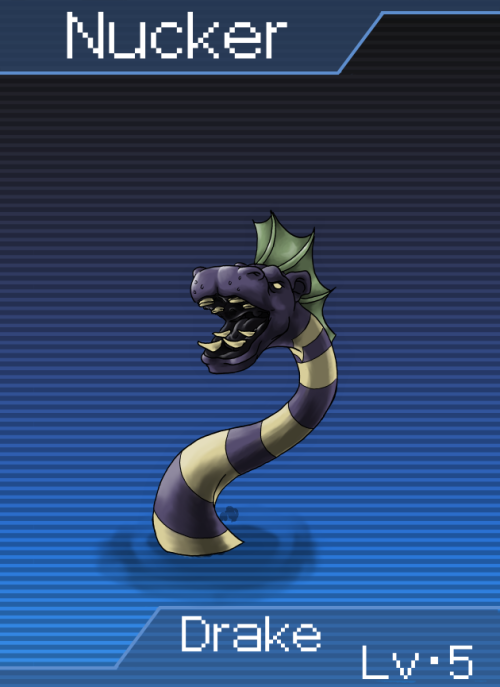
01 of 05 - Modern Compendium: Kishin Family, Part 3 - Drake Nucker
The Nucker is a myth on the verge of extinction. See, a long time ago, people thought every stream and lake had its own attendant serpent, and the early Anglo-Saxon people called these critters Nicor. They were said to hide at the bottom of pools of water, guarding fabulous treasure. The beast evolved over time to become a general water serpent, known in modern times as the Nucker.
These days, the Nucker is actually kind of obscure. This actually struck me as kind of weird at first; after all, it seems like every pond and lake in modern times has become home to weird cryptid snake critters, or at least sightings of them. But it occurs to me that most serpents that have surfaced in the last hundred years or so have been named beasts, with a strong connection to the area around them. They serve as a strong identifier of local culture, which isn’t something a more general jack-of-all-trades serpent can do. After all, what kind of sign would a sideshow make for a Nucker? “Come see OUR Nucker, it’s cooler than the Nucker they’ve got over in the next town!”?
Incidentally, a little further back in etymological history the word “nicor” was the Anglo-Saxon word for both “water spirit” and, for some reason, “hippopotamus.”
The Nucker is one of the lowest-leveled demons in the Modern Compendium, and one of the first demons you’re likely to ever encounter. It’s a bulky demon for its level, and actually offers some nice recovery magic for the early game, making it a decent critter to chat up for low level players. It’s also one of the few demons with an evolution, which we’ll be covering later.
For more info on this and every other demon in the Modern Compendium, have a look at our Data File, right over (here).
-
 abstractscarecrow reblogged this · 10 years ago
abstractscarecrow reblogged this · 10 years ago -
 koshercarcosan reblogged this · 10 years ago
koshercarcosan reblogged this · 10 years ago -
 protodile liked this · 10 years ago
protodile liked this · 10 years ago -
 primaeros reblogged this · 10 years ago
primaeros reblogged this · 10 years ago -
 carabbit liked this · 10 years ago
carabbit liked this · 10 years ago -
 historyclasses reblogged this · 10 years ago
historyclasses reblogged this · 10 years ago -
 alchefire liked this · 10 years ago
alchefire liked this · 10 years ago -
 turtlesworldofwhut liked this · 10 years ago
turtlesworldofwhut liked this · 10 years ago -
 abstractscarecrow reblogged this · 10 years ago
abstractscarecrow reblogged this · 10 years ago -
 abstractscarecrow liked this · 10 years ago
abstractscarecrow liked this · 10 years ago -
 rougealienpirate liked this · 10 years ago
rougealienpirate liked this · 10 years ago -
 xerozohar liked this · 10 years ago
xerozohar liked this · 10 years ago -
 downtroddendeity liked this · 10 years ago
downtroddendeity liked this · 10 years ago -
 yuber liked this · 10 years ago
yuber liked this · 10 years ago
More Posts from Historyclasses
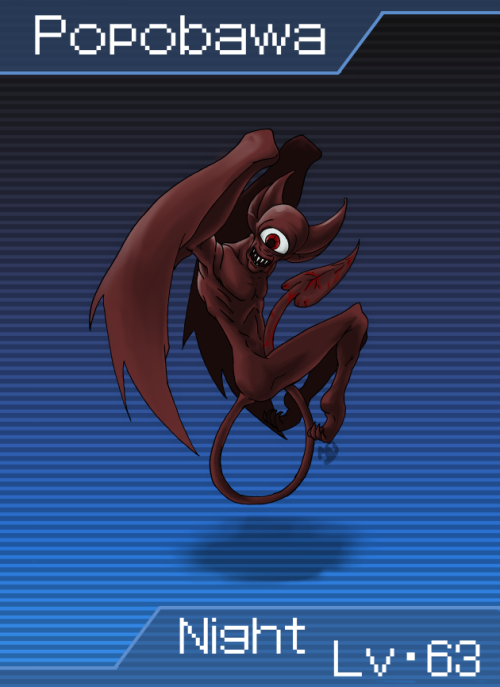
01 of 05 - Modern Compendium: Kishin Family, Part 5 - Night Popobawa
The mythology of Tanzania, an African country on the eastern coast of the continent, is a fascinating mix of ideas from Christianity, Islam, and myriad native folk religions. In modern times, these ideas have combined with politics and western Cryptozoology to create a truly novel demon known as the Popobawa.
The characteristics of the Popobawa are actually fairly similar to the Incubus of ancient Christian belief; a dark spirit, sometimes summoned by a sorcerer, to sexually assault people, usually women, in their sleep. However, the Popobawa is said to be a shapeshifter, only recognizeable by its bat-winged shadow – in fact the name “Popobawa” actually translates to “bat wing.” The creature is also said to be responsible for Poltergeist-like activity in homes and other physical attacks.
Popobawa reports have been responsible for several mass panics in Tanzania’s history, the most recent being in 2007. A couple of odd quirks in the creature’s mythology have helped this along; first, the idea that a Popobawa’s attacks can only be stopped by telling someone about them; and second, the fact that these reports multiply during election season. That’s right, there is a distinct possibility that we are looking at politically motivated fear mongering in the shape of a shadowy cycloptic man-bat. At least it’s more straightforward than color-coded terror charts, I guess.
At any rate, the Popobawa rates pretty high in the Night family, largely thanks to the heights of terror it inspires in populations that believe in it. Mechanically, it actually takes the place of the Succubus as the go-to Charm-based sex demon, though it is of course a bit more physically specialized.
For more info on this and every other demon in the Modern Compendium, have a look at the Data File, right over (here)!
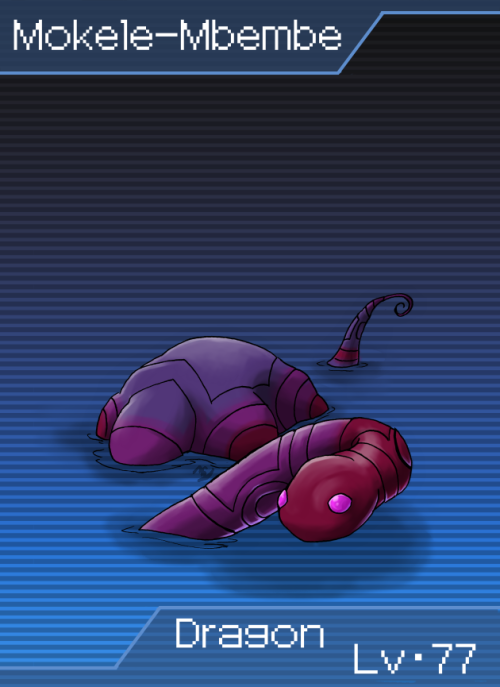
04 of 05 - Modern Compendium: Kishin Family, Part 5 - Dragon Mokele-Mbembe
One of the most famous Cryptids, Mokele-Mbembe is actually an excellent example of the way cultural mythologies color the way different societies interact. Physically, it straddles the divide between lost beast and sea serpent, while the mythology associated with it flits between pseudoscience and spiritualism.
See, in the Congo River basin region of Africa, locals have stories of a massive, wrinkled beast that wades in the rivers – the name “Mokele-Mbembe” actually means “the one who stops the flow of rivers.” They describe it as a nature spirit, a territorial beast, and a guardian of the water.
However, to westerners, the Mokele-Mbembe is something else. Explorers who visited the region in the early 20th century heard tales of a wrinkled, long-necked herbivore in the waters and, rather than taking the local’s stories at face value, decided they were describing a sauropod dinosaur. Since then, the Mokele-Mbembe has been taken up by Cryptozoologists as a likely living fossil, a survivor from prehistory when dinosaurs roamed the earth.
There is, of course, little evidence to support this theory, but the effect that the overlay of Cryptid mythology on Mokele-Mbembe has had on the imagination of the west is undeniable. Stories of long-lost dinosaurs in Africa have influenced countless popular movies, from King Kong to Land of the Lost, and helped to establish Africa in the minds of westerners as a place where mystical beasts wandered free.
In Shin Megami Tensei terms, Mokele-Mbembe is a mid-range Dragon. Like most of its family, the critter is largely defensive in nature, but it is also one of the few demons to learn Doping, making it a valuable addition to any player’s Compendium.
For more info on this and every other demon in the Modern Compendium, have a look at our Data File, right over (here).
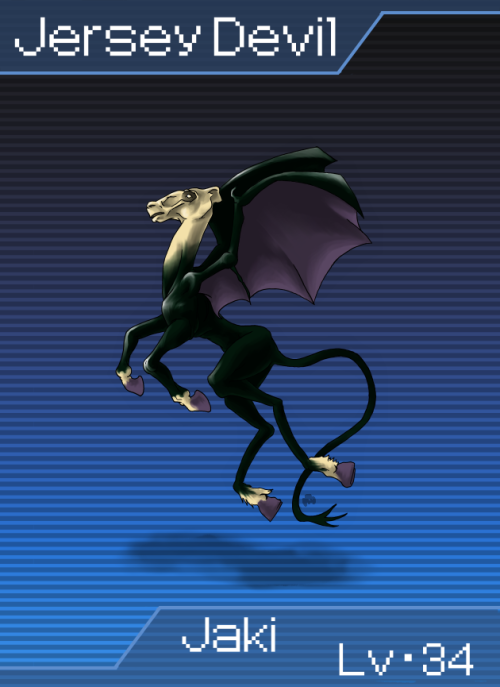
03 of 05 - Modern Compendium: Deity Family, Part 3 - Jaki Jersey Devil
One of the few demons from the official Demonic Compendium to make its way into this project, the Jersey Devil is a shoe-in for the Modern Compendium. Modern America has thoroughly embraced this demon, to the point where there is actually a hockey team called the Jersey Devils. It is deeply ingrained in popular culture, sitting amongst such figures as Bigfoot and Nessie in the collective consciousness.
The myths around the Jersey Devil have a few significant permutations, but the basic story goes like this; In the mid-18th century, the Leeds family lived in the back woods of New Jersey. Mother Leeds gave birth to twelve healthy children, but by the 13th child, she was fed up. As the 13th was born, she shouted, “This one shall belong to the Devil!” The child transformed into a hideous monster, killed Mother Leeds and the midwife, and flew up the chimney and out into the night.
Some variations of the story cast Mother Leeds as a witch who slept with the Devil, while others tell stories of clergymen who exorcised the Jersey Devil, sealing it for hundreds of years. My favorite versions of this story are the ones that include random famous people from history, like the version of the Bell Witch myth that have her tormenting Andrew Jackson. The Jersey Devil is said to have shocked the brother of Napoleon Bonaparte, amongst others, which is just awesome.
These days, the Jersey Devil has been largely recast as a Cryptid, a real, but undiscovered, animal, rather than the spawn of Satan. Which is just another example of people using pseudoscience to fill the mythological gaps left in modern life by scientific advancement. It may seem silly for modern man to believe in a horse-headed, bat-winged demon living in the pine barrens of the East Coast, but an undiscovered six-limbed animal with no precedent in the fossil record? No problem.
At any rate, the Jersey Devil has always occupied a rather moderate place in the Demonic Compendium, and he returns to pretty much the same place here. He fits perfectly in the Jaki family, which in the Modern Compendium represents man-eating monsters who are tied to a specific place.
For more info on this and every other demon in the Modern Compendium, have a look at our extensive and expanding Data File, right over (here)!
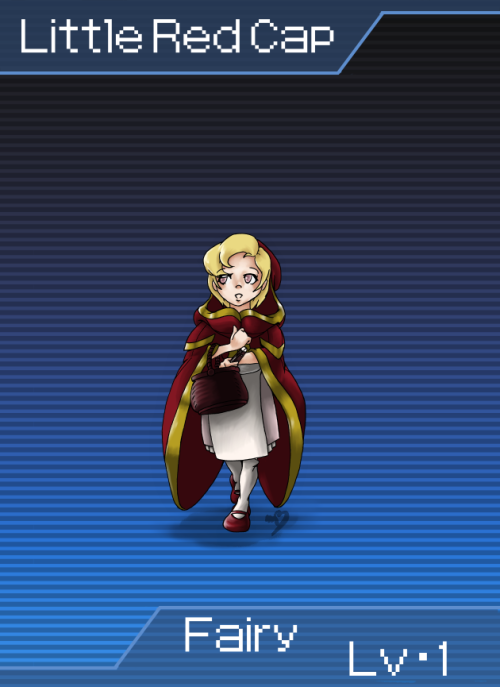
01 of 05 - Modern Compendium - Fairy Little Red Cap
This WAS going to be just a reblog to show I updated Little Red Cap’s artwork, but Tumblr doesn’t let you edit your stuff that way anymore. But that’s okay, I’m not really happy with how the old post reads anyway. So let’s do the whole thing over again! 8D
Anyway, Little Red Cap, better known as Red Riding Hood, is a perennially popular figure from fairy stories. The basic story is of course well known; a young girl is sent off to bring food to her ailing grandmother, but she has to go through the woods to get to grandma’s house. Along the way, a wolf stalks her, learns where she’s going, and gets to the house first, where she eats the girl’s grandmother. Little Red Riding Hood arrives at the house and engages in a battle of wits with the wolf, with the girl suspicious of her grandmother’s new appearance. There are a lot of variations on the ending, but usually the girl and her grandmother escape unscathed.
The popularity and extremely long history of Red Riding Hood’s story means there is a huge number of variations on the story. Sometimes the grandmother is eaten, sometimes she’s just imprisoned. Sometimes Red Riding Hood is saved by a woodcutter, and sometimes she outsmarts the beast. Heck, sometimes the wolf is a werewolf and LRRH actually has no cape on. Some scholars believe the story has origins as far back as the 10th century AD, so there may be as much as a thousand years worth of variation to work with here.
There is one major defining thing about the story that never changes. The underlying message of Little Red Riding Hood’s story is that there is a clear delineation between HERE, which is safe, and the scary, dangerous, wolf-infested THERE, and that wandering into it is not a good idea. I feel like that’s a good way to start a Shin Megami Tensei story - by announcing that you’ve just wandered into a very dangerous place that you should not be.
See, Little Red Cap is the Modern Compendium’s Pixie. She’s the first demon you meet, and she’s more or less your introduction to how demon allies work. She’s also capable of mass destruction should you level her high enough, learning Megidolaon at Lv. 65, which is actually a lower level than most other demons who get the skill. I admit this is equal parts a reference to the high-powered late game Pixie of Nocturne and my own love of cute things that are secretly capable of mass destruction.
For more info on this and every other demon in the Modern Compendium, have a look at our Data File, right over (here).
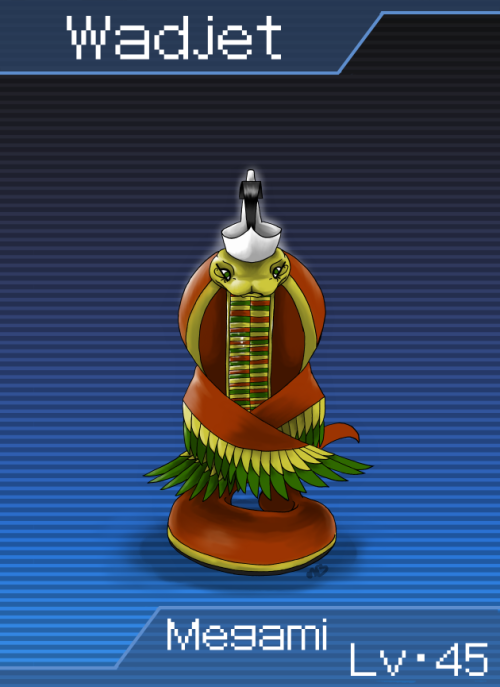
02 of 05 - Modern Compendium: Kishin Family Part 4 - Megami Wadjet
Although modern matriarchal religions tend to simply create the religious figures they need, many branches of these religions are not above adopting gods and goddesses from other belief systems. Wadjet is a good example of this. Originally a goddess of protection and motherhood from the Lower Kingdom of Egypt, Wadjet has been adopted by some practitioners of Neopaganism. Surprisingly, there’s fairly little alteration between her old home and the new one; she’s still seen as a guardian, particularly of expectant mothers, and she’s still seen as a winged snake.
Interestingly, in addition to being a goddess of motherhood, Wadjet was also the personification of the Eye of Horus. The Eye was an intensely important symbol to ancient Egyptians, symbolizing the protection of the gods and the wisdom of Horus himself. Modern Neopagans seem to have adopted this idea almost without alteration; whether this is out of respect or because Egyptian religion was in vogue when many goddess religions came to prominence will probably never be clear. It is, however, an interesting interaction between two societies separated by thousands of years, and a good reminder that no belief system is dead if someone – anyone – remembers it.
Wadjet sits fairly low in the Megami family; fact is, belief in her just isn’t that widespread. She is an exemplar of the Megami family, though. Wadjet sports high Magic, and comes loaded with powerful healing and defensive magic for her level. Personally, I see her as being one of those annoying enemies you tend to meet about midway through the game that heals the enemy team. Always target the healer first!
For more info on this and every other demon in the Modern Compendium take a look at the Data File, right over (here).